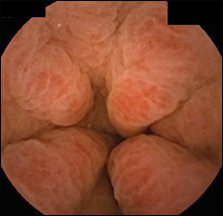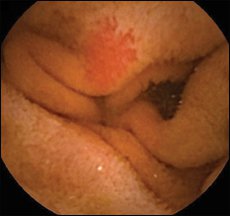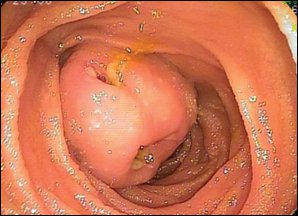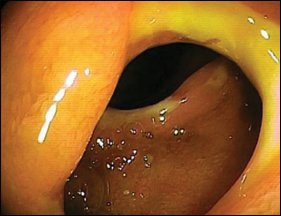Positive FOBT, Unidentified Bleeding Source Bring Enteroscopy into Question
Q: Several ER Trips for a 56-Year-Old for SOB and Iron-Deficient Anemia Reveal Positive FOBT, but EGD and Colonoscopies did not Identify the Bleeding Source. He Takes NSAIDs Regularly for Arthritis. Is There a Role for Enteroscopy?
A: This is a classic description of symptomatic obscure–occult gastrointestinal (GI) bleed. The patient is a gentleman with persistent anemia, and the GI tract is the suspected source of bleeding despite prior negative but appropriate endoscopy. This case of obscure GI bleeding can be further categorized into an obscure-occult GI bleed because there are no overt signs of GI bleeding, although the patient is dependent upon iron supplementation. The usual approach in the diagnostic algorithm of an obscure GI bleed would be a second-look endoscopy, as up to 12% to 25% of lesions can actually be found within reach of a standard endoscope. These lesions include Cameron erosions within a hernia sac, gastric antral vascular ectasias (GAVE; Figure 1), duodenal arteriovenous malformation (AVM) or ulcerations, as well as a cecal Dieulafoy. Despite not being cost effective, a second look endoscopy/colonoscopy is warranted, especially if the initial colonoscopy did not have an adequate preparation, or not enough biopsies were obtained in the distal duodenum to rule out celiac sprue at the time of the upper endoscopy.
When the repeat endoscopy has been completed and is negative, it is logical to rule out underlying small-bowel pathologies as the cause of bleeding. If the patient does not have obstructive symptoms, it would be appropriate to consider capsule endoscopy (CE) because it can safely examine the entire small bowel with a diagnostic yield of approximately 60% to 70%. In addition, the yield for capsule endoscopy is higher and best utilized in cases of male gender, inpatient status, greater than a 4-g drop in hemoglobin, overt GI bleeding, and history of connective tissue disease. Additionally, some studies suggest that if the capsule is deployed within 24 to 72 hours of the sentinel bleed, then there will be a higher diagnostic yield. I try to deploy the capsule as close to the timing of the sentinel bleed as possible. Finally, it is well proven that CE has a higher diagnostic yield compared to barium small-bowel follow through or push enteroscopy.
The most common diagnosis on capsule endoscopy is angiectasia (Figure 2) or vascular lesion, followed by small-bowel tumor (Figure 3), NSAID enteropathy, and Crohn’s disease (Figures 4 and 5). The definitive outcome of capsule endoscopy is dependent not only on the type of finding, but also the subsequent therapy employed, such as small-bowel resection for a tumor or medical treatment for inflammatory Crohn’s disease, as validated by balloon- or device-assisted enteroscopy.

Figure 1. GAVE on capsule endoscopy.

Figure 2. Angiectasia on capsule endoscopy.
Images: Mann NK

Figure 3. Submucosal tumor (GI stromal tumor) on double balloon enteroscopy.

Figure 4. Deep, linear ulcers in Crohn’s disease on capsule endoscopy.

Figure 5. Ulcerated ileal Crohn’s strictures.

Figure 6. Diaphragm stricture on capsule endoscopy.
If positive pathology is identified on CE, then double- or single-balloon enteroscopy can then be utilized to not only validate the capsule endoscopy findings but also to offer a definitive treatment for the underlying pathologies, such as argon plasma coagulation treatment of vascular malformation(s) or removal of small-bowel polyps. Double-balloon enteroscopy has the added benefit of achieving total enteroscopy compared to single-balloon enteroscopy or Spirus enteroscopy (Spirus Medical); however, the diagnostic yield is the same. In addition, in a cost-effective analysis, early use of DBE was the most cost-effective method for the diagnosis and management of obscure GI bleeding when compared to push enteroscopy, intraoperative enteroscopy, and small bowel imaging.
However, managing some small-bowel lesions, such as angiectasias, do not always lead to a definitive outcome. In this case, the definitive outcome we expect is the complete resolution of anemia without the need for iron supplementation. When it comes to angiectasias, outcomes data on DBE are less promising. Some studies have found that despite DBE and treatment of angiectasias, 30% of patients will rebleed in 1 year and up to 50% in 3 years. This often occurs because patients continue to use chronic anticoagulant/antiplatelet therapy, and/or the underlying comorbid condition, such as valvular heart disease or arrhythmia, still persists.
On the other hand, our patient’s underlying issue is the chronic use of NSAIDs, which can lead to small-bowel ulcers, and in some cases, small-bowel stricture(s) formation. In this case, DBE may actually lead to a definitive therapeutic outcome. Specifically, DBE can not only identify the culprit lesion such as diaphragm strictures (Figure 6), but also one can mark or tattoo the location of the first and the last stricture. This is helpful for the subsequent surgical planning and preservation of normal small bowel. In addition, only DBE and CE can identify these types of strictures, as they are not readily seen or appreciated on small-bowel follow-through or other dedicated small bowel imaging, such as CT enterography or magnetic resonance enterography. More importantly, because the overlying serosa is normal, the surgeon may not be able to identify the lesion as well while in the OR. This is where DBE can lead to a definitive change in outcome in the setting of an obscure GI bleed — complete resolution of iron deficiency anemia. Obviously, the patient should also be advised to stop taking all NSAIDs.
Excerpted from:
Leung J, Lo SK. Curbside Consultation in Endoscopy: 49 Clinical Questions, Second Edition (pp 45-49) ©2014 SLACK Incorporated.
References
Raju GS, et al. Gastroenterology. 2007;133(5):1694-1696.Fry LC, et al. Aliment Pharmacol Ther. 2009;29(3):342-349.
Robinson CA, et al. Gastrointest Endosc. 2011;74(5):1061-1066.
Singh A, et al. Gastrointest Endosc. 2013;77(5):761-766.
Marmo R, et al. Aliment Pharmacol Ther. 2005;22(7):595-604.
May A, et al. Am J Gastroenterol. 2010;105(3):575-581.
Gerson L, Kamal A. Gastrointest Endosc. 2008;68(5):920-936.
For more information on the Curbside Consultation in Gastroenterology Series:
Visit Healio.com/Books/Gastroenterology.
